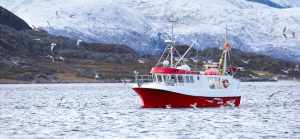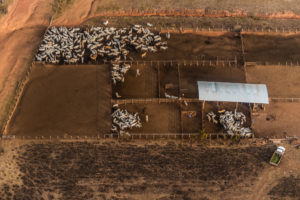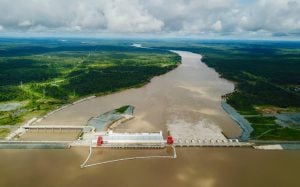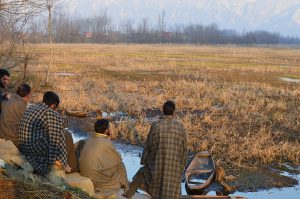Marcy Trent Long: Welcome to China’s Polar Frontiers, a podcast series by Sustainable Asia. My name is Marcy Trent Long.
This is episode two of China’s Polar Frontiers. In this series we look at why climate change has piqued China’s interest in the polar regions. As we learned in episode one, China seeks to secure new fishing grounds in the Antarctic waters to feed its growing population. This puts them in direct opposition to conservationists trying to close off large areas of the ocean from distant-water fishing. But as we also learned, with proper scientific monitoring and research, sustainable use could be a viable strategy even in these frozen habitats vulnerable to climate change.
Now, in part two, we head north to the Arctic.
Zhao Huiyu: The rapid economic development in China over the past few decades has had a definite impact on the Arctic.
Marc Lanteigne: I’ve been very interested in how the Arctic has turned into, I wouldn’t say a primary foreign policy concern for China, but certainly one which is growing in importance.
Marcy: Dr Zhao Huiyu of Shanghai Jiao Tong University and Dr Marc Lanteigne from the Arctic University of Norway have been studying China’s strategy in the Arctic for years. Along with other experts, they’ll help us figure out why China is so interested in the Arctic and how China’s advance into this highly political landscape is being received by Arctic nations.
Marc: If you compare China to, let’s say, the UK or France or Germany, China does not have a very long history in the Arctic, and it’s been very sporadic. So I would say that China only really got serious about the region about 10 years ago.
Marcy: In 2015, China announced that the poles were one of their four “new strategic frontiers”. Dr Anne-Marie Brady of the University of Canterbury in New Zealand and author of the book: China as a Polar Great Power.
Anne-Marie Brady: The new strategic frontiers that China has identified are areas of the world that are either international spaces, or have undetermined sovereignty, or are places where there are opportunities for countries to move into without having sovereignty over them. So the new strategic territories are the deep seabed, the Arctic and Antarctic, outer space and cyberspace. So China is looking to where it can expand and where there are resources that it can access.
Marcy: Dr Liu Nengye of Adelaide University explains this further. You may remember him from our first episode on the Antarctic.
Liu Nengye: Because of the advancement of technology, climate change [and] shifting geopolitical landscapes, the rules governing those frontiers are changing as well. That’s exactly where China sees how they can play a bigger role in global governance so that the rules that govern those new frontiers will to a large extent represent or reflect China’s interest in those frontiers.
Marcy: And that approach is all well and good in the Antarctic, as we learned in episode one. The South Pole region is largely empty of active territorial claims. There are a few scattered islands that belong to old colonial powers, but the Antarctic mainland and much of the surrounding ocean is an international common area where mining and military activities are banned. But the Arctic is a completely different story. Dr Henry Huntington of Ocean Conservancy explains.
Henry Huntington: Every speck of land in the Arctic belongs to one of the countries that’s already there. There’s nothing left.
Marcy: When we say the Arctic, we’re usually referring to the area within the Arctic circle, the 66th parallel that runs just north of Iceland. So the term “the Arctic” includes territorial waters and land that belong to the United States, Canada, Denmark’s Greenland, Iceland, Norway, Sweden, Finland and Russia. These eight countries are sometimes called the Arctic Eight. The only area of the Arctic that doesn’t belong to the Arctic Eight is a mostly frozen area called the central Arctic ocean. So when China announced the Arctic as one of its “new strategic frontiers”, it ruffled some feathers.
Henry: I think the Arctic countries are understandably very concerned about their sovereignty and unlikely to give much or any of that up.
Liu: They were worried [about] what would be China’s real intentions [and] whether China would respect the existing legal framework in the Arctic. Why do they want to get involved in the Arctic? How are they going to do that?
Marcy: So in January 2018, China tried to ease everyone’s worries by releasing a white paper detailing its intentions in the Arctic. Zhao Huiyu breaks down the three main points of China’s Arctic policy.
Zhao: We’re very concerned about the common interest of the Arctic, including the environment. That’s why, in this policy paper, our official policy is: protect the Arctic environment and respond to climate change, make sustainable use of the Arctic resources according to international law and increase our exploration and understanding of the Arctic.
Marcy: While China does not have any sovereign territory in the Arctic region, they’ve recently rebranded themselves as a “near-Arctic state” with great interest in the sustainable development of the Arctic. To understand how China seeks to increase its role in the region, we’ll take a deeper look at these three policy points, starting with the first: responding to climate change.
Temperatures in the Arctic are heating up faster than anywhere else on earth. According to the latest report by the UN panel on climate change, the last few winters in the Arctic were 6C warmer than average. The polar ice caps are receding at a rate of 13% each year, and as frozen groundwater thaws, large sinkholes form on land, forcing entire indigenous villages to relocate southwards. And the effects of a warming Arctic are felt around the world.
Marc: In China, there is mounting proof that what is happening in the Arctic in terms of climate change is having a knock-on effect in China through various ways. So Beijing has argued that: “Look, we are seeing the results directly of Arctic climate change, we would like to know more, and we would like to be able to do that in cooperation with Arctic actors.”
Shi Yubing: Climate change in the Arctic will directly affect climate change in China, which will cause environmental problems in China. So on this issue, China sees itself as a stakeholder.
Marcy: That was Dr Shi Yubing, a professor at Xiamen University in China. He explained how China participates in climate change research in the Arctic.
Shi: Much of our energy is devoted to conducting marine research in the Arctic waters. We also have a scientific research station. So that is an example of how China aims to gain a better understanding of the Arctic.
Marcy: On to the second point of China’s Arctic policy: sustainable use of resources.
Marc: China is seeing the Arctic as a very important place for economic development. And that includes mining, fossil fuels, fishing, shipping… Just, essentially, the opening up of the Arctic is something that China very much wants to keep an eye on from an economic viewpoint.
Marcy: To gain access to these resources, China is developing a network of shipping routes and infrastructure investments along the Russian and Scandinavian Arctic coastline. They call it the Polar Silk Road, an extension of their massive investment plan, the Belt and Road Initiative. This string of investments connecting Asia with Europe is often regarded with suspicion. Observers are worried that some of these loans can lead to debt traps in developing countries. But in the remote Arctic, China’s interest is welcomed with open arms. Dr Mia Bennett, a professor at the University of Hong Kong, has travelled all along the Polar Silk Road.
Mia Bennett: I do think that there is a real desire in these places that have been ignored by their own governments and other foreign governments in terms of receiving investment. Now this is a chance to develop and gain infrastructure and capital. So I don’t think this animosity towards Chinese investment is necessarily widespread in the places where the Belt and Road is touching. I think there are certainly places that are excited about these opportunities presented.
Marc: China cannot say that [they] have any kind of sovereignty there. It is very dependent on the goodwill of Russia and the other Arctic states to develop this kind of economic activity. So China has been stressing that: “We want to be a partner, we want to help develop all kinds of different joint ventures.”
Marcy: One of these joint ventures is the Yamal liquified natural gas project on the frozen shores of northern Russia.
Mia: So this is on the Yamal peninsula, which sticks out like a sore finger in the middle of Siberia up into the Arctic ocean. And it’s just chock full of natural gas, and this has been known for decades, and there’s been extraction going on for a while. But as that extraction has ramped up in the past decade or so, as the Russian gas industry has moved farther north, the Russian industry needs more investment.
Marcy: Because of sanctions against Russia, European Union investment was limited, and Moscow naturally turned to their eastern neighbour for funding. China jumped in through its state-owned National Petroleum Corporation and a US$15 billion loan from the Silk Road Fund. Since December 2017, 15 Russian icebreakers carry natural gas to clients east and west.
Mia: The shipping of that gas is interesting, because in wintertime it goes west, towards Europe. But then in the summertime, the gas is able to be shipped along the north coast of Russia all the way to Asia.
Marcy: Traditionally, only icebreakers can withstand the heavy sea ice along Russia’s northern coastline to make it all the way across to the Pacific. But that’s likely to change soon. Two years ago, a specially-built Russian gas tanker made it from Norway to South Korea without the help of icebreakers. While this is a sad reminder of the state of the Arctic sea ice, it does provide an opportunity for Pacific manufacturing hubs to ship wares to markets along the Atlantic coast both faster and cheaper. Shi Yubing and Liu Nengye explain.
Liu: The Chinese shipping industry is also quite curious and interested in using the northeast passage because that connects the two big markets. On the one hand is the East Asian market: China, South Korea, Japan. And on the other end, it’s the European market: Rotterdam, Antwerp and Hamburg.
Shi: At the moment, China’s main international shipping channel passes through the South China Sea and the Strait of Malacca before heading west.
Liu: China relies heavily on the Strait of Malacca to connect China with the European market. That is an area which can be geopolitically not stable from time to time.
Shi: In the future, going via this new international shipping channel, we could save ten days’ time and a lot of fuel.
Marcy: Shipping along the Polar Silk Road is still limited. In 2018, just over 800 ships applied for a permit to sail in Russia’s Arctic waters, and over half of those were tugboats and support vessels for oil rigs in the area. But as the route sees ice-free summers more regularly, shipping is likely to increase, and we can expect a larger impact on the Arctic environment. Peter Winsor is director of the Arctic programme at WWF.
Peter Winsor: The amount of shipping is increasing rapidly, and with that comes a number of concerns for us within WWF. One is that the ships themselves are contributing to air pollution and also contributing to soot particles. Soot particles, or black carbon, is something that locally makes the ice and snow cover darker, which actually helps to melt the ice and snow itself.
Marcy: When soot particles land on Arctic ice, they cover the white plains in a dark blanket, warming up in the sun and causing the ice to melt even faster.
Peter: [An] even greater concern, maybe, is that there will be a catastrophic event at some point. We are concerned about the current inability for the Arctic nations to deal with a potential catastrophic spill in the Arctic.
Marcy: In case of a spill, liquified natural gas shipped from Yamal would evaporate, so the environmental damage wouldn’t be too tragic. But when it comes to offshore oil drilling, like with China’s mobile drilling rig Nanhai-8, we’re still underprepared to deal with spills and human casualties in this unforgiving region of the world. So it’s very important to regulate Arctic shipping before this northern sea route starts competing with the alternative routes as a transport artery. After a short break, we’ll look at existing safety regulations, and China’s contribution to the protection of the Arctic.
Break to thank sponsors.
Shi: The legislation on shipping in the Arctic is actually completed. For example, you may have heard of the International Maritime Organization, the IMO.
Marcy: This is Shi Yubing again. The International Maritime Organisation regulates shipping under the United Nations.
Shi: In 2015, they passed a regulation called the Polar Code. Any ship that sails in Arctic waters has to stick to Polar Code requirements on environmental protection and safety. These requirements are pretty strict. This is a way to ensure that when you sail through the Arctic, marine pollution can be minimized.
Henry: The Polar Code is a set of guidance or regulatory or advisory measures.
Marcy: Henry Huntington of Ocean Conservancy tells us more.
Henry: And this includes both the capabilities of the ships to make sure we didn’t have ships in remote areas that really shouldn’t be there, because they would wind up needing help of some kind that would be hard to get, and also training for crews so that they knew what to expect going into Arctic waters, which may give them very different conditions and challenges than they would get elsewhere.
Marcy: But not everyone is equally happy with the Polar Code. Remember the black carbon Peter Winsor of WWF mentioned earlier? It causes soot particles to cover the ice, melting it even faster.
Mia: In Antarctica, ships can’t use what’s called heavy fuel oil, which releases a lot of black carbon.
Marcy: Mia Bennett of the University of Hong Kong.
Mia: But in the Arctic, they’re still allowed to. And that exception is because I think basically, it would have been too hard for companies to suddenly switch to more expensive types of shipping fuels. So I think still the commercial interests are driving, maybe, a lack of environmental protection in the Arctic.
Peter: There is a lack of regulatory structure for shipping in general. There’s good work being done. But actually what’s in place now, it’s not sufficient for the current state of the Arctic, and definitely doesn’t account for the increased shipping that we know is going to happen here within the next five years.
Marcy: But even within the International Maritime Organisation, calls are made for a stricter Polar Code, and Chinese companies like shipping giant COSCO are also strong advocates for a strengthening of these regulations.
Henry: Part of the reason for that is, if there’s some kind of a disastrous accident, let’s say a ship runs aground or breaks apart and spills oil along the coast, in public opinion, they won’t be making a distinction between the company that had the problem and all the other companies that didn’t have that problem and have been doing their best to avoid having problems. Public opinion will just paint the entire shipping industry and all of Arctic shipping with the same brush. And if you’re trying to be a responsible operator, like COSCO, that would be a real shame that your efforts are being undermined by the poor practices and behaviour of somebody else.
Marcy: But will a strong Polar Code also be enough to safeguard the fragile Arctic ecosystem?
Peter: I think [in] the end, there will be parts of the Arctic that are too valuable from an ecosystem sense that you [will] actually have to ban some areas from shipping altogether.
Marcy: While the International Maritime Organisation regulates shipping in the region, most other Arctic issues are actually overseen by another international body, the Arctic Council. The Arctic Council brings us to the third point in China’s Arctic policy: China wants to increase their understanding of the Arctic and gain a larger influence in the way the region is governed. Mia Bennett and Marc Lanteigne can tell us more.
Mia: Originally, you have just countries managing their northern territories, the eight countries. Then in the 90s, following the end of the Cold War and the greater desire among these eight states to cooperate and protect the region, whose environment they saw as vulnerable, they decided to form this Arctic Council.
Marc: What it is designed to do is to be acting as a nexus of various ideas and policies to deal with social development, with environmental conditions, to deal with northern maritime issues, to act as a place for debate for indigenous peoples. It was essentially designed to be a meeting place, if you will.
Mia: So you have each of the governments represented as permanent members. And then what’s quite unique about the Arctic Council is that they also incorporate six indigenous peoples’ organisations as permanent participants. So there are six permanent participants representing various indigenous groups throughout the Arctic.
Marcy: Every two years, the Arctic Council comes together to review and update existing agreements or to listen to the latest research reports prepared by one of the many working groups.
Marc: Most of the serious day-to-day work by the Arctic Council is actually done by the working groups. Now, these are special select committees that have been created to deal with very specific Arctic areas. Many of them are working on climate change, some of them are monitoring climate conditions, some are dealing with specific types of pollutants.
Marcy: Marc-André Dubois worked with WWF as an observer to one of these working groups.
Marc–André Dubois: It’s really fun to work within the Arctic Council because, first, it’s a small community of people, but also because you get to travel to really remote and crazy areas. I think there is definitely a sense of community within the Arctic Council structure and working groups.
Marcy: In the late 90s and early 2000s, the Arctic Eight and the indigenous groups were joined by a few European states who gained observer status at the meetings. Many of these countries, like Spain and the UK, had long-distance fleets that would fish in sub-Arctic waters like the Barents Sea north of Scandinavia, so it made sense for them to be involved in Arctic governance. But after a while, a few of the Asian fishing nations started wondering why they too were not included in the Arctic group. China was one of them.
Mia: I think there was a general consensus, at least within China, that the country was rising in prominence as an economic actor, as a political actor, that wanted to be involved in global governance and seen as a good citizen within that world. And the Arctic, as it became increasingly this “poster child” region for climate change, as a place where a lot of the world’s governments felt that interventions needed to be made, I think China did not want to be left out of those discussions.
Marcy: So in 2013, China, India, Japan, South Korea and Singapore joined the Arctic Council as observers. They had no voting power in the general meetings, but they became involved in the working groups, which discussed scientific research into climate change, pollution and wildlife conservation. I asked Dr Timo Koivurova, an Arctic Council delegate from Finland, how China has contributed to the work of the council.
Timo Koivurova: My own personal observation, on the working level, they can be very active, especially if it is something of interest to China. The Arctic migratory birds initiative is a good example. The idea is that those birds that breed in the Arctic region, many of them, of course, are also going through China, and the measures done in China are also very important from the viewpoint of their health in the long term.
Marcy: Marc-André Dubois was also working with the Arctic Council when the Asian nations joined.
Marc–André: From what I could see, it was a steep learning curve for those delegations in terms of understanding the very specific processes, where you have the concept of permanent participants, which are actually international, indigenous organisations that are at the same table [as] the Arctic states. Many Asian observer states to the council mostly brought forward their scientific knowledge. I think there is a lot of work to identify what Asian countries can bring to the table, actually.
Marcy: While some are sceptical about China’s Arctic ambitions, most nations agree that China’s presence in the Arctic Council is a good thing, as it offers the opportunity for dialogue about issues of conservation and development. Russia is China’s greatest partner in the region, and the two countries work together to develop the Polar Silk Road, increasing shipping and extraction activities along Russia’s Arctic coast. The Nordic countries of Finland, Sweden, Norway and Iceland are also open to Chinese investment in their Arctic space.
Marc: You’re seeing a general sense of enthusiasm for the potential [of] the Belt and Road to assist with their economies. Iceland has a free-trade agreement with China, it’s been in place since 2014. Norway, after a long period of diplomatic freeze, the talks are back on, and there’s even the possibility that an agreement might be struck by the end of this year or early next. And the other Nordic states are also wondering: “OK, what are the potential economic benefits, if you will, of China playing a greater role in the Arctic?”
Marcy: No surprise, there is one Arctic player that does not share that positive attitude towards China’s northern interest.
Marc: The United States has been concerned that what China is really seeking to do is to create an Arctic identity where none exists. Just over the past few months, we’ve seen really strong signs from the Trump government that attempts to challenge China’s role in the region. There’s been all kinds of references by US policymakers to say: “We are the Arctic states, you are not, therefore your plans lack a certain amount of legitimacy.”
Marcy: In May of 2019, Timo Koivurova was in the room when US Secretary of State Mike Pompeo gave a scathing speech to the Arctic Council.
Mike Pompeo speech: China’s words and actions raise doubts about its intentions. Beijing claims to be a near-Arctic state. Yet the shortest distance between China and the Arctic is 900 miles. There are only Arctic states and non-Arctic states. No third category exists, and claiming otherwise entitles China to exactly nothing.
Timo: He was accusing both China and Russia. China for being too much present and regarding itself as a near-Arctic state, and also perhaps having a long-term military agenda in the region, which seems to be a fairly far-fetched argument.
Marc: For starters, yes, the trade war between the US and China and overall poor relations are playing a role. I think the US is feeling that it has to check China’s influence wherever it may. I think this is also a product of the fact that, up until this year, the Trump government has largely ignored the Arctic. And there’s a sense that we need to make up for lost time. And I think a third point is that, with the US government stressing up and down that climate change does not exist, pointing to China, and more specifically pointing to the Russia-China relationship, has been a way for the US to at least attempt to change the narrative, to say: “No, no, the real security issue here is the Russia-China partnership. That is the biggest challenge to the Arctic.”
Marcy: This comes at a time when the Arctic really needs strong cooperation to mitigate and adapt to climate change. There’s no overarching treaty system like in the Antarctic, which acts as a platform for all countries to manage their interests in the region, whether that’s fishing, mining, shipping or scientific research. Marc Lanteigne and Henry Huntington.
Marc: The Arctic is opening up, and the Arctic is going to be subject to a great deal of scrutiny and a great deal of increased economic activity. I think there will need to be something – call it an Arctic treaty, call it whatever you want – that is going to have to be looked at very carefully, because otherwise the current system of having a lot of Arctic affairs being overseen by simply eight countries, may not be sustainable for much longer.
Henry: I don’t know whether we’ll ever see an Arctic treaty like the Antarctic one, even for the central Arctic ocean, but what we see are a number of steps that together combine many of the elements that you would want to see. So my hope is that we will continue to see this emphasis on international cooperation, and in different ways continuing to work together to find ways to be responsible and to help each other. That’s my vision for the Arctic. We’re on a good path, if we can stay on it, to responsible international cooperation for the benefit of the Arctic. And to me, that’s a wonderful thing.
Marcy: There are only a few environmental issues as pressing as the protection of the Arctic. We’re already seeing dramatic changes to the Arctic landscape, and while these changes can offer economic opportunities, most countries agree that scientific research and environmental conservation are a high priority. China seems to be one of those countries, as it has positioned itself firmly as a stakeholder in Arctic governance.
China’s Arctic policy gives us an idea of their intentions in the region. China faces direct consequences of Arctic climate change and wants to expand their research capacity, explore the economic opportunities along the Polar Silk Road and they want to influence the way the Arctic is governed. For now, China is finding its feet in the existing frameworks, and by encouraging cooperation and inclusivity, Arctic nations can ensure that China continues to join the global effort to sustainably develop the region.
In these two episodes, we saw how China has recently gained access to the rooms where the future of the Polar regions is decided. China can bring a very different perspective to these talks, and the rest of the world is slowly adjusting to this new reality. Over the next few years, collaboration and fruitful negotiation in these meetings will be crucial to protecting these extraordinary frozen worlds.
China’s Polar Frontiers is hosted by me, Marcy Trent Long, and produced by Samuel Colombie in collaboration with China Dialogue. The series is mixed by Chris Wood.
Thanks to all our guests for helping us unravel this complicated issue, and to Dr Tang Jianye, Dr Richard Steiner, Dr Rasmus Bertelsen, Margot Stiles, Kim Yeonsik, Dr Candace Newman and Dr Alf Hakon Hoel, whose voices didn’t make it on this podcast but whose interviews were crucial to our understanding of this topic. Thanks to Azzam Khan and Wu Yufei for their voice-overs and Alexander Mauboussin for his intro and outro music, made from repurposed and recovered waste items. Additional thanks to Mark Roberts for his Arctic sound recordings and to the entire Sustainable Asia team: Bonnie and Heidi Au, Jill Baxter, Josie Chan and Crystal Wu. We couldn’t have done it without you.
APPLE PODCASTS | SPOTIFY | YOUKU
Production credits:
Executive producer and host: Marcy Trent Long
Producer: Samuel Colombie
Sound engineer: Chris Wood
Intro/outro music: Alex Mauboussin






